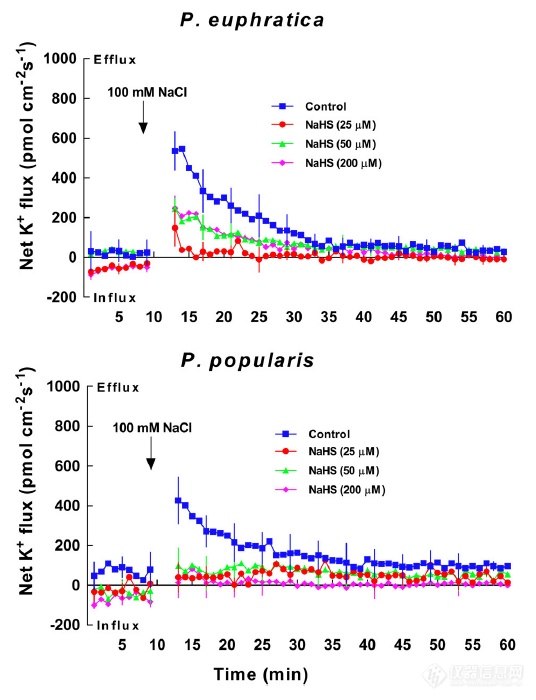硫化氫介導(dǎo)鹽脅迫下耐鹽和鹽敏感楊樹離子動(dòng)態(tài)平衡成果發(fā)表
NMT歷*的今天
2018年9月19日,北京林業(yè)大學(xué)陳少良、林善枝、趙楠、孫健利用NMT在Frontiers in Plant Science上發(fā)表了標(biāo)題為Hydrogen Sulfide Mediates K+ and Na+ Homeostasis in the Roots of Salt-Resistant and Salt-Sensitive Poplar Species Subjected to NaCl Stress的研究成果。

期刊:Frontiers in Plant Science
主題:硫化氫介導(dǎo)鹽脅迫和鹽敏感楊樹種根系中的K+和Na+穩(wěn)態(tài)
標(biāo)題:Hydrogen Sulfide Mediates K+ and Na+ Homeostasis in the Roots of Salt-Resistant and Salt-Sensitive Poplar Species Subjected to NaCl Stress.
影響因子:3.678
檢測(cè)指標(biāo):K+、Na+、H+流速
檢測(cè)部位:楊樹根部(距離根尖300um)
K+、Na+、H+流實(shí)驗(yàn)處理方法:
一年生的胡楊幼苗,在對(duì)照,對(duì)照加NaHS(50mM),NaCl(50mM)和NaCl(50mM)加上NaHS(50mM)這四種處理分別處理24小時(shí)和5天
K+、Na+、H+流實(shí)驗(yàn)測(cè)試液成份:
0.1 mM KCl, 0.1 mM CaCl2, 0.1 mM MgCl2, 0.5 mM NaCl, 0.2 mM Na2SO4, and 0.3 mM MES, pH 4.0
作者:北京林業(yè)大學(xué)陳少良、林善枝、趙楠、孫健
英文摘要
Non-invasive micro-test techniques (NMT) were used to analyze NaCl-altered flux profiles of K+, Na+, and H+ in roots and effects of NaHS (a H2S donor) on root ion fluxes in two contrasting poplar species, Populus euphratica (salt-resistant) and Populus popularis (salt-sensitive).
Both poplar species displayed a net K+ efflux after exposure to salt shock (100 mM NaCl), as well as after short-term (24 h), and long-term (LT) (5 days) saline treatment (50 mM NaCl, referred to as salt stress). NaHS (50 μM) restricted NaCl-induced K+ efflux in roots irrespective of the duration of salt exposure, but K+ efflux was not pronounced in data collected from the LT salt stress treatment of P. euphratica.
The NaCl-induced K+ efflux was inhibited by a K+ channel blocker, tetraethylammonium chloride (TEA) in P. popularis root samples, but K+ loss increased with a specific inhibitor of plasma membrane (PM) H+-ATPase, sodium orthovanadate, in both poplar species under LT salt stress and NaHS treatment. This indicates that NaCl-induced K+ loss was through depolarization-activated K+ channels. NaHS caused increased Na+ efflux and a corresponding increase in H+ influx for poplar roots subjected to both the short- and LT salt stress.
The NaHS-enhanced H+ influx was not significant in P. euphratica samples subjected to short term salt stress. Both sodium orthovanadate and amiloride (a Na+/H+ antiporter inhibitor) effectively inhibited the NaHS-augmented Na+ efflux, indicating that the H2S-enhanced Na+ efflux was due to active Na+ exclusion across the PM. We therefore conclude that the beneficial effects of H2S probably arise from upward regulation of the Na+/H+ antiport system (H+ pumps and Na+/H+ antiporters), which promote exchange of Na+ with H+ across the PM and simultaneously restricted the channel-mediated K+ loss that activated by membrane depolarization.
中文摘要
非侵入性微測(cè)試技術(shù)(NMT)用于分析NaCl中改變的根中K+,Na+和H+的通量分布以及NaHS(H2S供體)對(duì)兩種對(duì)比楊樹胡楊(Populus euphratica)根系離子通量的影響(耐鹽)和Populus popularis(鹽敏感)。
在暴露于鹽休克(100mM NaCl)之后,以及在短期(24小時(shí))和長(zhǎng)期(LT)(5天)鹽水處理(50mM NaCl,參考)之后,兩種楊樹物種都表現(xiàn)出凈K+外排。作為鹽脅迫)。無(wú)論鹽暴露的持續(xù)時(shí)間如何,NaHS(50μM)都限制了NaCl誘導(dǎo)的根中的K+流出,但是從胡楊的LT鹽脅迫處理收集的數(shù)據(jù)中K+流出不明顯。
NaCl誘導(dǎo)的K+流出受到K+通道阻滯劑,四乙基氯化銨(TEA)在P.pularis根樣品中的抑制,但K+損失隨著特異性質(zhì)膜抑制劑(PM)H+ -ATPase,原釩酸鈉在楊樹中的增加而增加。 LT鹽脅迫和NaHS處理下的物種。這表明NaCl誘導(dǎo)的K+損失是通過(guò)去極化激活的K+通道。 NaHS導(dǎo)致Na+流出增加,并且受到短鹽和LT鹽脅迫的楊樹根的H+流入相應(yīng)增加。
經(jīng)受短期鹽脅迫的胡楊(P. euphratica)樣品中NaHS增強(qiáng)的H+流入量不顯著。原釩酸鈉和阿米洛利(Na+ / H+逆向轉(zhuǎn)運(yùn)蛋白抑制劑)均有效抑制NaHS增強(qiáng)的Na+流出,表明H2S增強(qiáng)的Na+流出是由于PM中的活性Na+排斥。因此,我們得出結(jié)論,H2S的有益作用可能源于Na+ / H+反向運(yùn)輸系統(tǒng)(H+泵和Na+ / H+反向運(yùn)輸)的向上調(diào)節(jié),其促進(jìn)Na+與H+在PM上的交換并同時(shí)限制通道介導(dǎo)的K+損失。通過(guò)膜去極化激活。

FIGURE 1丨Effects of NaHS on NaCl shock-altered transient K+ kinetics within P. euphratica and P. popularis root samples. Young root samples of P. euphratica and P. popularis were equilibrated for 30 min in a basic solution [NaCl (0.1 mM), MgCl2 (0.1 mM), CaCl2 (0.1 mM), and KCl (0.5 mM)] supplemented with or without 25, 50, and 200 µM NaHS. Thereafter, K+ kinetics were recorded at meristems (300 µm from the root tip) for ca. 40 min after NaCl shock. The salt shock (100 mM NaCl) was given by adding acquired amount of NaCl stock (0.2 M, pH 6.0 adjusted with NaOH and HCl) to the measuring solution. Before the NaCl shock, steady-state K+ fluxes were recorded for 10 min. Each point is the mean of five individual plants and bars represent the standard error of the mean.
 您好, 歡迎來(lái)到化工儀器網(wǎng)
您好, 歡迎來(lái)到化工儀器網(wǎng)
